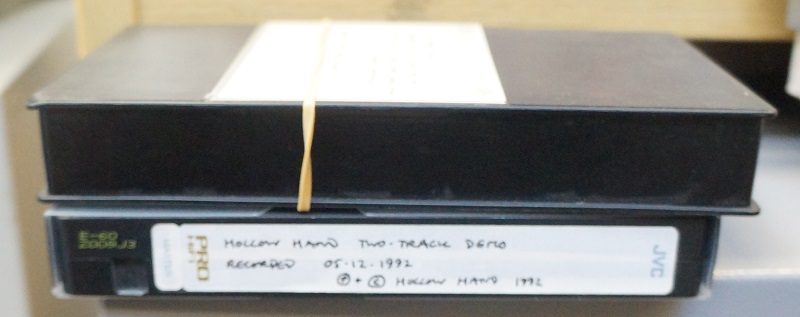The history of amateur recording is peppered with examples of people who stretched technologies to their creative limit. Whether this comes in the form of hours spent trying things out and learning through doing, endlessly bouncing tracks in order to turn an 8-track recording into a 24-track epic or making high quality audio masters on video tape, people have found ways to adapt and experiment using the tools available to them.

One of the lesser known histories of amateur home recordings is making high quality stereo mixdowns and master recordings from multi-track audio tape onto consumer-level Hi-Fi VCRs.
We are currently migrating a stereo master VHS Hi-Fi recording of London-based indie band Hollow Hand. Hollow Hand later adopted the name Slanted and were active in London between 1992-1995. The tapes were sent in by Mark Venn, the bass player with Slanted and engineer for these early recordings that were recorded in 1992 in the basement of a Clapham squat. Along with the Hi-Fi VHS masters, we have also been sent eight reels of AMPEX ¼ tapes of Slanted that are being transferred for archival purposes. Mark intends to remix the eight track recordings digitally but as of yet has no plans for a re-release.
When Mark sent us the tapes to be digitised he thought they had been encoded with a SONY PCM, a mixed digital/ analogue recording method we have covered in a previous blog post. The tapes had, however, been recorded directly from the FOSTEX eight track recorder to the stereo Hi-Fi function on a VHS video tape machine. For Mark at the time this was the best way to get a high quality studio master because other analogue and digital tape options, such as Studer open reel to reel and DAT machines, were financially off-limits to him. It is worth mentioning that Hi-Fi audio technologies were introduced in the VHS model by JVC around 1984, so using this method to record stereo masters would have been fairly rare, even among people who did a lot of home recording. It was certainly a bit of a novelty in the Great Bear Studio – they are the first tapes we have ever received that have been recorded in this way – and take it for granted that we see a lot of tape.
Using the Hi-Fi function on VHS tape machines was probably as good as it got in terms of audio fidelity for those working in an exclusively analogue context. It produced a master recording comparable in quality to a CD, particularly if the machine had manual audio recording level control. This is because, as we wrote about in relation to PCM/ Betamax, video tape could accommodate greater bandwidth that audio tape (particularly audio cassette), therefore leading to better quality recordings.
One of our replacement upper head drums
VHS Hi-Fi audio is achieved using audio frequency-modulation (AFM) and relied on a form of magnetic recording called ‘depth multiplexing‘. This is when
‘the modulated audio carrier pair was placed in the hitherto-unused frequency range between the luminance and the colour carrier (below 1.6 MHz), and recorded first. Subsequently, the video head erases and re-records the video signal (combined luminance and colour signal) over the same tape surface, but the video signal’s higher centre frequency results in a shallower magnetization of the tape, allowing both the video and residual AFM audio signal to coexist on tape.’
Challenges for migrating Hi-Fi VHS Audio
Although the recordings of Hollow Hand are in good working condition, analogue masters to VHS Hi-Fi audio do face particular challenges in the migration process.
Playing back the tapes in principle is easy if both tape and machine are in optimum condition, but if either are damaged the original recordings can be hard to reproduce.
A particular problem for Hi-Fi audio emerges when the tape heads wear and it becomes harder to track the hi-fi audio recording because the radio frequency signal (RF) can’t be read consistently off the tape. Hi-Fi recordings are harder to track because of depth multiplexing, namely the position of the recorded audio relative to the video signal. Even though there is no video signal as such in the playback of Hi-Fi audio, the video signal is still there, layered on top of the audio signal, essentially making it harder to access. Of course when tape heads/ drums wear down they can always be replaced, but acquiring spare parts will become increasingly difficult in years to come, making Hi-Fi audio recordings on VHS particularly threatened.
In order to migrate tape-based media to digital files in the most effective way possible, it is important to use appropriate machines for the transfer. The Panasonic AG-7650 we used to transfer the Hollow Hand tapes afforded us great flexibility because it is possible to select which audio tracks are played back at any given time which meant we could isolate the Hi-Fi audio track. The Panasonic AG-7650 also has tracking meters which makes it easy to assess and adjust the tracking of the tape and tape head where necessary.
As ever, the world of digitisation continues to generate anomalies, surprises and good stories. Who knows how many other video/ audio hybrid tapes are out there! If you do possess an archive collection of such tapes we advise you to take action to ensure they are migrated because of the unique problems they pose as a storage medium.